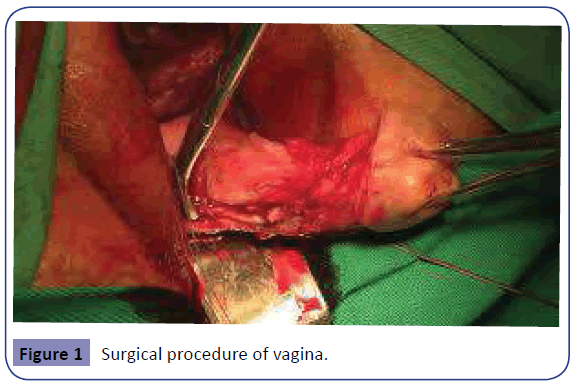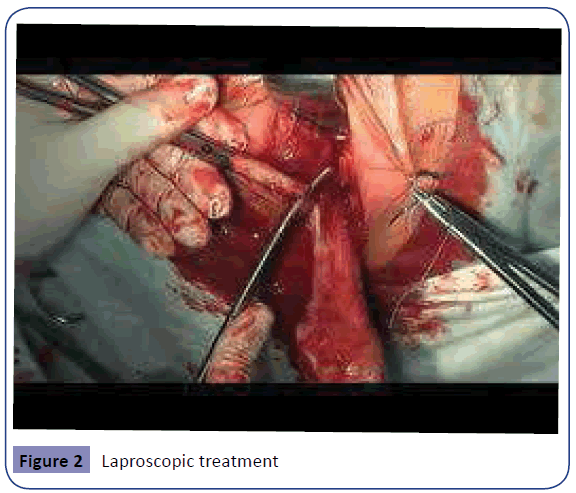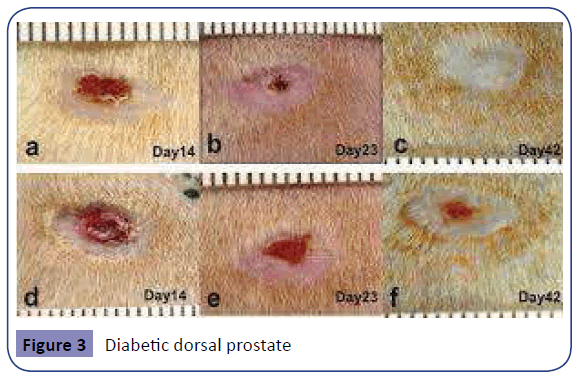Intrapartum Diagnosis and Treatment of Longitudinal Vaginal Septum
Stephene Mello Vistar, Demisew Amenu, Supanimit Teekachunhatean, Surapan Khunamornpong, Nejat Ozgul,Fu-Fen Yin, Yasmine El-Masry
Demisew Amenu, Supanimit Teekachunhatean, Surapan Khunamornpong, Nejat Ozgul, Fu-Fen Yin, Yasmine El-Masry
Department of Gynecology, Aarhus University, Vennelyst Boulevard 9, Denmark
- Corresponding Author:
- Stephene Mello Vistar
Department of Gynecology, Aarhus University
Vennelyst Boulevard 9, Denmark
Tel: +45-789-53821 +45-789-53821
E-mail: stephenemello2011@outlook.com
Received Date: October 15, 2015, Accepted Date: November 17, 2015, Published Date: November 22, 2015
Citation: Amenu D, Teekachunhatean S, Khunamornpong S, et al. Intrapartum Diagnosis and Treatment of Longitudinal Vaginal Septum. Crit Care Obst&Gyne. 2015, 1:1. doi:10.21767/2471-9803.100004
Abstract
Reason: Diabetes is connected with expanded lower urinary tract side effect (LUTS) seriousness. A basic reason for LUTS is expanded prostate smooth muscle tone. A basic controller of prostate innervation and tone is nitric oxide (NO), created by nitric oxide synthase (NOS). Since NO manages expansion and unwinding, and NOS flagging is adjusted in patients with LUTS, we recommend that diminished NO in diabetic patients prompts expanded LUTS. We analyzed this theory by measuring changes in NOS motioning in the BB/WOR diabetic rodent prostate.
Materials and Methods: Protein and RNA wealth and restriction of NOS I, - II and - III were analysed in control and diabetic BB rodent prostate by Real time RT-PCR, Western, immunohistochemical investigation and in situ. Morphological changes were analyzed by electron microscopy (EM), and TUNEL.
Results: NosIII is the most bounteous isoform in ventral and dorsal prostate. NOS I, - II and - III protein and RNA limit to ductal epithelium. NOS III protein and RNA were fundamentally diminished in diabetic prostate. Apoptosis was expanded in diabetic dorsal prostate. EM of the diabetic dorsal prostate indicated rich protein filled vacuoles what's more, irregular cytoplasmic morphology demonstrative of apoptosis.
Conclusion: Since NOS III is the most rich type of NOS in the prostate diabetes may add to LUTS seriousness by down managing NO, which may prompt expanded multiplication in ductal epithelium.
Keywords
Gynecology, Maturity, Pregnancy, Endometriosis
Introduction
Male lower urinary tract symptoms (LUTS) encompass a variety of urologic symptoms including increased obstructive and storage symptoms. The prevalence of LUTS increases with age [1]. In the United States in 2000, 4.5 million visits to physicians for LUTS diagnosis occurred with total treatment costs of 1.3 billion dollars [2]. In spite of the high number of affected individuals and the cost of their health care, the underlying cause(s) of age related male LUTS remains controversial and is often attributed to benign prostatic hyperplasia (BPH) [3]. Previous studies have focused on age and androgen fluctuation as potential risk factors, however there is increasing evidence that a diverse group of comorbidities including diabetes mellitus (DM), obesity and components of the metabolic syndrome, contribute to LUTS severity [4,5]. Several important studies support an association between diabetes and LUTS [4,6,7]. Diabetes is associated with a 1.78 fold higher risk of developing LUTS [8] and a recent review concluded that diabetes has a profound influence on risk of LUTS development [6]. Emphasis has been placed on BPH as the underlying risk factor for LUTS, ignoring the potential for pelvic/ prostate ischemia and alteration in prostatic smooth muscle tone as contributing factors. A critical regulator of prostate innervation, smooth muscle tone and pelvic perfusion is nitric oxide (NO) derived from nitric oxide synthase (NOS). NOS is the enzyme responsible for synthesis of NO from L-arginine in nonadrenergic/ non-cholinergic nerve terminals and in endothelium. NO is a widely distributed neurotransmitter that has been shown to regulate apoptosis, tissue remodeling, cellular proliferation, angiogenesis, and maintenance of smooth muscle tone [9]. Several isoforms of NOS exist including neuronal NOS (NOS I or nNOS, found in nerve terminals), inducible NOS (NOS II or iNOS, involved in the inflammatory response), and endothelial NOS (NOS III or eNOS, present in endothelial cells). In prostate, NOS I has been identified in the epithelium, stroma, and nerve filaments [9]. NOS II is available in stroma of BPH patients yet not in ordinary prostate [9], and NOS III has been recognized in basal cells of the glandular epithelium [9]. In human prostate, NOS assumes a part in smooth muscle tone and unwinding, neuronal innervation and the regulation of vascular, secretory and hormonal pathways [10,11]. In the event that NOS plenitude is diminished in diabetic prostate, as was appeared in other genitourinary organs, for example, the penis [12], this diminishment in relate smooth muscle tone may show as obstructive and/or irritative voiding and along these lines introduce a putative component of how LUTS seriousness is expanded in diabetic patients. Despite the fact that adjustments in NOS plenitude and restriction have been seen in patients with LUTS, the impact that DM has on NOS motioning in the prostate has not been beforehand analyzed. Accordingly in this study we have inspected the confinement and measured changes in NOS protein and RNA plenitude in the BB/ WOR rodent prostate a model that impersonates sort I diabetes in people. We estimate that diminished NOS motioning in diabetic rats will bring about morphological changes in the prostate that may add to expanded side effect seriousness of LUTS in diabetic men.
Materials and Methods
Creatures
Postnatal day 120 (P120) Sprague-Dawley rats were gotten from Charles River. BB/WOR diabetes safe (control) and diabetic rats were gotten from Biomedical Research Models, Inc., Worcester, MA. The vicinity of diabetes was dictated by measuring blood glucose levels (Biomedical Research Models), with onset creating between P60 and P120. Rats were P160 to P190 when relinquished, with 70 to 100 days of diabetes term. Control BB rats were age coordinated. All creatures were watched over as indicated by the National Institute of Health Rules for the Care and Use of Laboratory Animals and conventions gotten institutional approbation. Diagram of Nos expression in the prostate by RTPCR RNA was detached from grown-up Sprague-Dawley rodent ventral, dorsal what's more, parallel (n=4) prostate with TRIzol (Invitrogen, Carlsbad, CA) as already depicted [12]. RT-PCR was performed on 150 ng RNA, testing for NosIII, NosII, NosIa, NosIb, and NosIc expression utilizing the Gene Amp RNA PCR Core unit (Perkin-Elmer, Branchburg, NJ) as portrayed beforehand [12]. Preliminaries were blended at the Northwestern University Biotechnology Facility and items were confinement processed to affirm they spoke to the grouping of interest.
Measurement of Nos expression utilizing Real time RT-PCR RNA was disengaged and DNase regarded as expressed beforehand [12] on control (n=4) and diabetic (n=4) BB/WOR ventral, dorsal and parallel prostate. cDNA was orchestrated from 300ng of RNA utilizing the Gene Amp RNA PCR Core pack (Perkin- Elmer, Branchburg, NJ, USA). Realtime RT-PCR was performed on the Opticon Monitor framework (Bio- Rad, Irvine, CA, USA) utilizing SYBR Green Super UDG blend (Invitrogen) as indicated by maker's proposals as beforehand portrayed [13]. Groundworks are illustrated (Integrated DNA Technologies, Coralville, IA) Negative controls without cDNA were rush to guarantee the nonattendance of pollution. Specificity of preliminaries was confirmed by melt bend investigation and sequencing. NosI, NosII, and NosIII were standardized. Two Ribosomal subunit L-19 (Rpl19), by the 2-ΔΔCT technique [14]. Examines were performed in triplicate on individual tissue examples, the outcomes found the middle value of and the item proportions reported as the mean give or take the standard mistake of the mean.
In situ hybridization
In situ hybridization was executed as depicted already [12] on control (n=5) and diabetic (n=5) dorsal and ventral prostates. Riboprobes for Nos-II and Nos-III were orchestrated as portrayed beforehand [15].
Immunohistochemical investigation (IHC)
IHC was performed on control (n=5) and diabetic (n=5) ventral, dorsal and horizontal prostate as depicted beforehand [11] utilizing the Dako LSAB + System, HRP. Areas were brooded with mouse monoclonal antibodies for NOS I, NOS II and NOS III (250μg/ml, Transduction Labs, Lexington, Kentucky). Areas were recolored with DAB furthermore, mounted utilizing Crystal Mount (Biomedia).
Tunel
TUNEL examine for apoptosis was performed by maker's guidelines utilizing the ApopTag pack (Intergen, Purchase, NY) on control (n=5) and diabetic (n=5) dorsal prostate as beforehand portrayed [13].
Electron microscopy (EM)
EM was executed as portrayed beforehand [12] on control (n=3) also, diabetic (n=3) dorsal prostate.
Results
Nos expression in prostate RT-PCR was performed to focus the circulation of Nos isoforms in Sprague-Dawley rodent prostate (n=4). NosIII was the most plenteous isoform in the ventral, dorsal and sidelong prostate (Figure 1). NosII and NosIa were additionally plentiful in the dorsal prostate what's more, NosIb in the sidelong prostate. Continuous RT-PCR of Nos expression in the prostate Continuous RT-PCR was performed to evaluate changes in Nos wealth in control (n=4) and diabetic (n=4) rodent prostate. NosIII was fundamentally diminished 62% in diabetic ventral prostate (p=0.0001), 75% in diabetic dorsal prostate (p=0.0001) and 37% in diabetic parallel prostate (p=0.008) (Figure 1). NosI was unaltered in control and diabetic ventral (p=0.38), dorsal (p=0.19), and parallel (p=0.21) prostate (Figure 2). NosII was unaltered in diabetic ventral prostate (p=0.60), however NosII expression was too low to measure in dorsal and sidelong prostate. NOS protein confinement by IHC in control and diabetic prostate. IHC investigation was utilized to limit NOS I, - II and - III proteins in control (n=5) and diabetic (n=5) BB/WOR rodent ventral, dorsal and horizontal prostate. NOS I protein was restricted in the epithelium of all three projections of control and diabetic prostate (Figure 3). The diabetic ventral prostate showed strange morphology with less stroma obvious between channels by visual perception and the pipes showed up to have lost their round structural planning (Figure 3). NOS I recoloring in the diabetic dorsal prostate seemed to have crevices in the epithelium that was not obvious in controls (Figure 3). NOS II protein was distinguished in ductal epithelium of control and diabetic ventral and dorsal prostates yet, was not present in control or diabetic horizontal prostate. NOS III protein was rich in control and diabetic ventral and dorsal prostate ductal epithelium. NOS III protein additionally had holes in recoloring in the diabetic dorsal prostate ductal epithelium that was not clear in controls. NOS III protein was recognized in diabetic parallel prostate yet not control horizontal prostate. In situ hybridization of NosII and NosIII in control and diabetic prostate. In situ hybridization was performed on control (n=5) and diabetic (n=5) ventral and dorsal prostate measuring for NosII and NosIII confinement. NosII and NosIII were confined in the ductal epithelium of control and diabetic ventral and dorsal prostate. Evaluation of NOS I and NOS III proteins in prostate by western examination. Western examination was performed on control (n=4) and diabetic (n=4) ventral, dorsal and horizontal prostate testing for NOS I/β-actin furthermore, NOS III/β-actin. NOS III/β-actin was essentially diminished 45% in diabetic ventral prostate (p-value=0.002), however stayed unaltered in diabetic dorsal (p-value=0.20) and in diabetic horizontal (p-value=0.48) prostate. NOS I/β-actin was expanded 95% (p=2.82 E-5) in diabetic ventral prostate and 90% (p=0.02) in diabetic horizontal prostate. NOS I/β-actin protein was expanded 79% in the diabetic dorsal prostate (p=0.079), however in light of the vast standard deviations, measurable essentialness was not came.
EM of control and diabetic prostate
EM was performed on control (n=3) and diabetic (n=3) dorsal prostate. Numerous protein filled vacuoles were distinguished in diabetic dorsal prostate however in control dorsal prostates the vacuoles were void. Anomalous cytoplasmic morphology was likewise seen in diabetic dorsal prostate that was not present in controls. The vicinity of dense chromatin that is segregated from the atomic film, vast vacuoles containing changed cell organelles and widened cisternae of the endoplasmic reticulum in the diabetic are suggestive of apoptosis [13,14]. Apoptosis in the diabetic dorsal prostate was affirmed by TUNEL [15].
Conclusion
The new DNA-based test will lessen this "false positive" rate while keeping up the identification rate for Down disorder. Comparative The new DNA-based test will lessen this "false positive" rate while keeping up the identification rate for Down disorder. Comparative In spite of the fact that African American ladies contrasted with White ladies have lower endometrial malignancy frequency rates (21.8 versus 24.8 for every 100,000 females), they have essentially higher death rates (7.3 versus 3.9 for every 100,000 females) and more regrettable 5-year survival rates (58.9% versus 84.7%) [3]. In spite of the fact that there are no screening tests to distinguish endometrial tumor, the dominant part of ladies (68%) present with unusual dying, possibly taking into account early recognition of the ailment [2]. This is basic on the grounds that the 5-year survival rate for endometrial tumor diminishes with conclusion at late stage (96%, 67%, or 16% for neighborhood, provincial, or far off stage, individually) [2]. Besides, the distinguishing proof of danger variables for endometrial growth are well established what's more, include: weight, expanded estrogen presentation on the grounds that recently onset of menopause, diabetes, tamoxifen use, and gang history/hereditary inclination [4,5].
Conflict of Interest
Authors have no conflict of interest.
Acknowledgement
Thank you to the institute for giving us chance to perform our research. We are thankful to the whole team and patients in collecting their data.
References
- Eysenbach G (2006) The open access advantage. J Med Internet Res 8: e8
- www.biomedcentral.com/info/presscenter/pressreleases?pr=20050623
- Palomaki GE, Kloza EM, Lambert-Messerlian GM, Haddow JE, Neveux LM, et al. (2011) DNA sequencing of maternal plasma to detect Down syndrome: An international clinical validation study. Genet Med 20: 1-8.
- Lo YM, Corbetta N, Chamberlain PF, Rai V, Sargent IL, et al. (1997) Presence of fetal DNA in maternal plasma and serum. Lancet 350: 485-487
- Down JL (1995) Observations on an ethnic classification of idiots 1886. Ment Retard 33: 54-56.
- Weiss M (1994) Conditional love: parents’ attitudes toward handicapped children. Bergin and Garvey.
- Ehrich M, Deciu C, Zwiefelhofer T, Tynan JA, Cagasan L, et al. (2011) Noninvasive detection of fetal trisomy 21 by sequencing of DNA in maternal blood: a study in a clinical setting. Am J Obstet Gynecol 204: 205.
- Marmot M, Wilkinson RG (2006) Social determinants of health (2nd Edn.), Oxford University Press, Oxford.
- Warnecke RB, Oh A, Breen N, Gehlert S, Paskett E, et al. (2008) Approaching health disparities from a population perspective: the National Institutes of Health Centers for Population Health and Health Disparities. Am J Public Health 98: 1608-1615.
- Yu CK, Rymer J (1998) Women's attitudes to and awareness of smear testing and cervical cancer. Br J Fam Plann 23: 127-133.
- Woloshin S, Schwartz LM, Black WC, Welch HG (1999) Women's perceptions of breast cancer risk: how you ask matters. Med Decis Making 19: 221-229.
- Katapodi MC, Dodd MJ, Lee KA, Facione NC (2009) Underestimation of breast cancer risk: influence on screening behavior. Oncol Nurs Forum 36: 306-314.
- Andersen MR, Bowen D, Yasui Y, McTiernan A (2003) Awareness and concern about ovarian cancer among women at risk because of a family history of breast or ovarian cancer. Am J Obstet Gynecol 189: S42-47.
- Seebacher V, Schmid M, Polterauer S, Hefler-Frischmuth K, Leipold H, et al. (2009) The presence of postmenopausal bleeding as prognostic parameter in patients with endometrial cancer: a retrospective multicenter study. BMC Cancer 9: 460.
- Kimura T, Kamiura S, Yamamoto T, Seino-Noda H, Ohira H, et al. (2004) Abnormal uterine bleeding and prognosis of endometrial cancer. Int J Gynaecol Obstet 85: 145-150.
Open Access Journals
- Aquaculture & Veterinary Science
- Chemistry & Chemical Sciences
- Clinical Sciences
- Engineering
- General Science
- Genetics & Molecular Biology
- Health Care & Nursing
- Immunology & Microbiology
- Materials Science
- Mathematics & Physics
- Medical Sciences
- Neurology & Psychiatry
- Oncology & Cancer Science
- Pharmaceutical Sciences



